INDIAN OCEAN TRAVEL by TOURISMER
INDIAN OCEAN TRAVEL by TOURISMER

Responsible travel Oman
Oman consists of desert, riverbed oases and long coastlines on the Persian Gulf, Arabian Sea and Gulf of Oman.
The Wahiba Sands are a region of dunes inhabited by the Bedouins.
The port capital Muscat has the massive and contemporary Sultan Qaboos Grand Mosque
You must see the old town of Matrah, with its labyrinthine souk and bustling fish market.
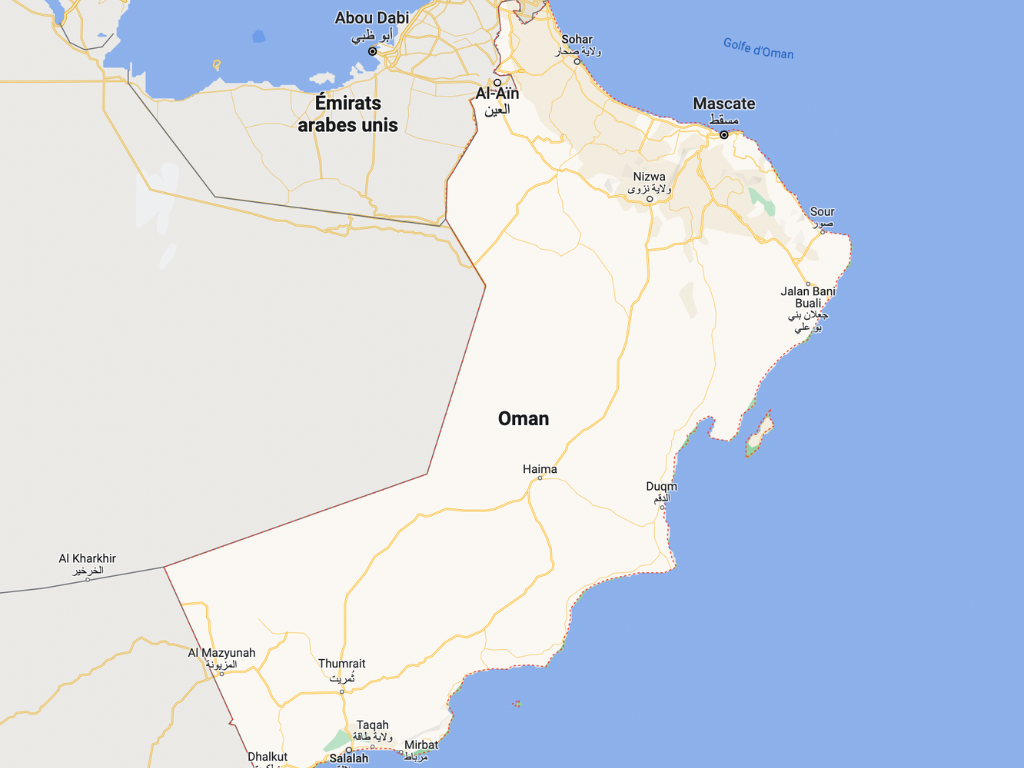
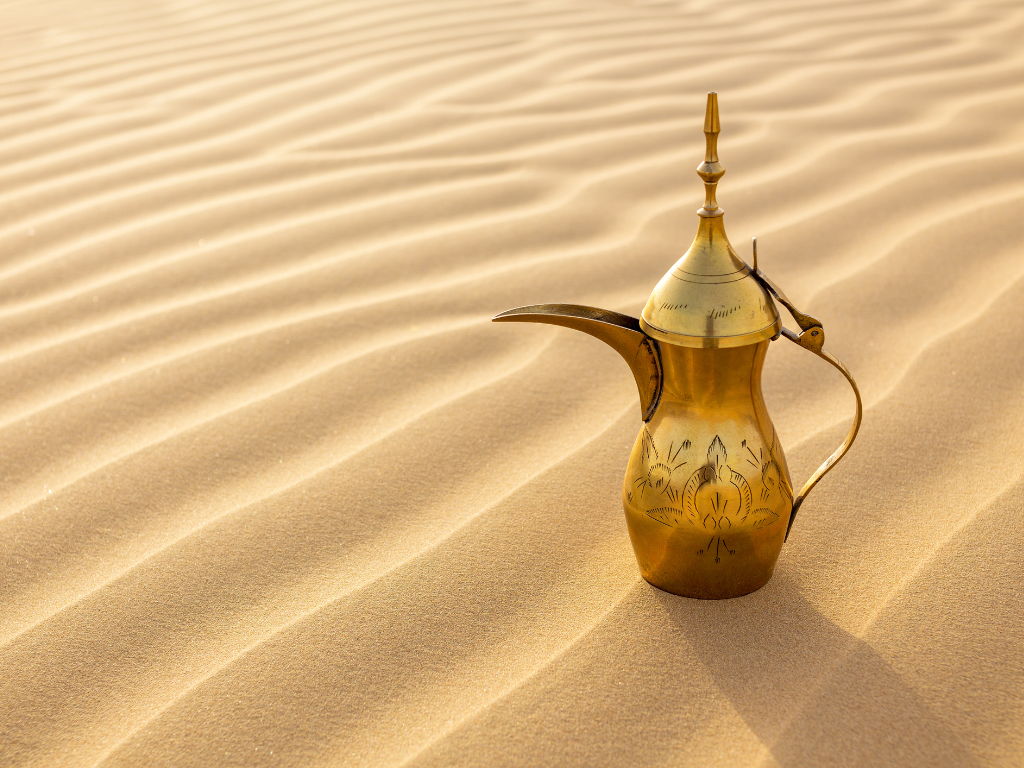
The challenge of sustainable tourism in Oman: undeniable assets of natural and historical heritage, a promising economic sector but also a requirement for spatial justice, at the heart of authentic regional planning.
In fact, the three pillars of sustainable development, namely the environmental pillar, the economic and the social. If tourism is then an economic promise, it is clear that it must preserve the country's assets and be at its service.
 We are supporting
We are supporting
Oman is in Antiquity an extension of the Yemeni territory and more precisely of Hadramout. The region of Oman was known in Sumerian times as Magan.
In antiquity, the peninsula became a major producer of incense, and it maintained an important commercial activity with Mesopotamia, Egypt, Persia, India and the island of Dilmun. Oman was one of the satrapies of the Persian Empire when it was incorporated into it, around 536 BC. J.-C.
Oman was Islamized during Muhammad's lifetime, in the VIIe century. In the VIIIe century, following the schism between Sunnis and Shiites, Oman is one of the rare regions to take another path, Kharidjism, and soon becomes the main region of Ibadi obedience.
The history of Oman only truly begins in the year 751 CE, with the election of the first Ibadi imam in Nizwa. While retaining its Ibadi imams as religious authority, the region was repeatedly dominated by major foreign powers during the Middle Ages.
The country was partially occupied by the Portuguese from 1507 to 1650. In 1649-1650, the Omanis, now led by the Yaroubid dynasty, drove out the Portuguese and seized at their expense the main Swahili ports on the East African coast: Mombasa, Kilwa , Zanzibar and Pemba, which allows them to control part of the very lucrative slave trade.
The Iranians partially occupied the country from 1737 to 1744. After the expulsion of the latter, Ahmed ibn Said was elected imam in 1749, thus founding the current dynasty. It is the beginning of a golden age for the Sultanate of Oman, which confirms its influence on the western Indian Ocean up to Madagascar.
At the beginning of the XIXe century, Oman became the center of a veritable colonial empire, which stretched from Balochistan to Zanzibar, and held its own against the Portuguese fleet and then the Royal Navy for several centuries. The sultanate was de facto placed under a British protectorate from 1891 to 1971, while nominally retaining its independence.
In 1970, Qabus has since undertaken the economic improvement of the country, while maintaining peace with all the other countries of the Middle East. The UN ranks the sultanate among the ten countries that have experienced the strongest development since 1970.
Today the Sultanate is prosperous.
The official language of Oman is Modern Standard Arabic, and although it is the language of writing and education, it is the Omani dialect that is spoken by Arabic-speaking Omanis.
Many migrant workers from South Asia speak Hindi, Bengali, Urdu, or Punjabi, as well as many other languages. English is spoken in the cities.
Even though the government of Oman does not keep statistics on religious affiliation, statistics from the CIA's World Factbook indicate that followers of Islam are in the majority at 85.9%, with Christianity at 6.5%. , Hinduism at 5.5%, Buddhism at 0.8% and Judaism less than 0.1%. The other religious affiliations have a proportion of 1% and the unaffiliated only 0.2%.
Literature
Khalîl Ibn Ahmad Al Farâhîdî (718-791) was born in Oman.
He published the first Arabic dictionary, the Kitab al-Ayn (Le livre source), probably completed by his disciple Al-Layth ibn Al-Muzaffar. Le livre source seeks to elucidate the origin of Arabic words.
Music
Omani music is located at a cultural crossroads between Arabia, East Africa, Persia, Balochistan and Portugal. This small country is home to a rich variety of music; 130 styles (funun) have been listed. Rhythm plays a major role with measures up to 108 beats. Music enjoys unparalleled popularity in Oman and the entire population actively participates in it. There are also characteristics similar to those of Yemeni music.

Traditional dance
Al-Bar'ah is a Bedouin musical tradition from the Dhofar mountain ranges in southern Oman. It takes the form of a warlike dance performed to the sound of the drum and poetry sung in the dialect of the local tribes. Al-Bar'ah is performed in a semicircle by ten to thirty men and women. While singing and clapping, two male dancers with khanjars (daggers), perform codified dance movements, brandishing their daggers above shoulder level.
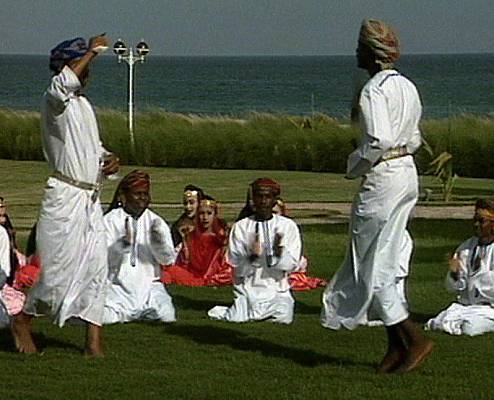
Handicrafts
The kandjar is an oriental white weapon. It is, in particular, the dagger with a very wide and curved blade worn at the waist by men in the Sultanate of Oman during ceremonies. It slips into the belt – silver or leather – which holds the dishdasha, the traditional costume.

Omani gastronomy, very influenced by Indian and Oriental cuisines, consists mainly of meat, fish cooked in tandoori style, tikka or masala.
Some emblematic dishes:
Shuwa
It is lamb cooked for a long time in the sun in banana leaves. This type of cooking allows the meat to reveal all its flavors, while preserving a moist and juicy texture.

Biryani, considered the Omani national dish, is a dish of Indian origin cooked with rice and spices. The biryani can be chicken, lamb or vegetables.
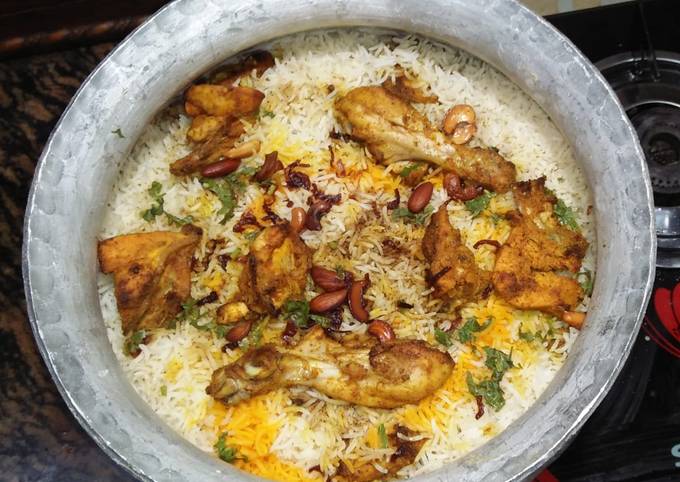
Source :https://cookpad.com/us/recipes/11254128-omani-chicken-biryani

It is the main mosque in Oman. Financed and commissioned by Sultan Qabus ibn Said, it was started in 1994 and inaugurated on . It is particularly known for having the largest one-piece handmade carpet (70 by 60 meters) and the largest candlestick in the world, set in gold 24 carats.
The rug is considered the largest handmade Persian rug made in the world, a unique piece of 5,625 m2 (larger than a football field), from 38 tons of wool and cotton.
Particular care is taken with the lighting, in particular thanks to 35 chandeliers in Swarovski crystal and gold-plated metal. The most spectacular is the central chandelier in the large prayer hall. Its diameter is 8 m, its height 14 m. It weighs eight tons. It owes its brilliance to the 1,122 bulbs that make it up.

Muttrah Souq is one of the oldest markets in Oman dating back two hundred years. It is located next to the port of Muscat and saw immense trade in the age of sailing, being strategically located on the route to India and China. It was named after the darkness due to the crowded stalls and alleys where the sun's rays do not filter through during the day and shoppers need lights to know their destinations. . The market was a source of supply for Omanis where they could buy their necessities in the 1960s, when the demands of life were simpler than today. Most goods were imported, in addition to local products such as textiles, fruits, vegetables and dates.

Misfah is a mountain village located in the north of the Sultanate of Oman, in Jebel Akhdar, the highest and most central massif of the Hajar Mountains, at an altitude of about 700 m. It is attached to the region of Ad-Dākhilīyah and located not far from the city of Al Hamra from where it is reached by a steep road.
Al-Hamra, has a pretty palm grove and beautiful old 2/3-storey mud houses built in the Yemeni style. Many of them are unfortunately abandoned and sometimes in ruins but the whole exudes a certain charm.

The wadis, rivers whose levels vary greatly depending on the weather (extremely powerful and dangerous in the event of rain), can prove to be heavenly places, in particular that of Wadi Shab.
Once you have crossed the village of Tiwi, the road for cars stops facing the wadi: once you have reached the end of the road, you will have to take a boat to cross most of the Wadi. This is where the walk begins in the rocky Omani paths. It will take about 45 minutes of walking and crossing 2 or 3 basins of water before you can admire the canyons and be able to swim in its transparent waters.

Sandwiched between the Gulf of Oman and the balcony houses, Muttrah Corniche was Oman's main port in the country's medieval maritime spice trade. Where the spice-laden dhows once departed, there are now souks, shops, restaurants and alleys where visitors and locals stroll, shop and soak up the Arabian atmosphere of yesteryear .
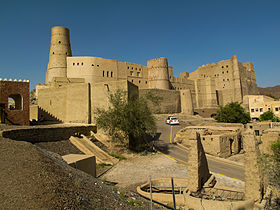
The Bahla fort is one of the four fortresses at the foot of Jebel Akhdar, the upper part of Oman. Located more precisely in the oasis of Bahla, it has been listed since 1987 on the World Heritage List. It was built by the Banu Nabhan community who dominated the region of XII century at the end of XV century. The building is made of adobe with a stone base.
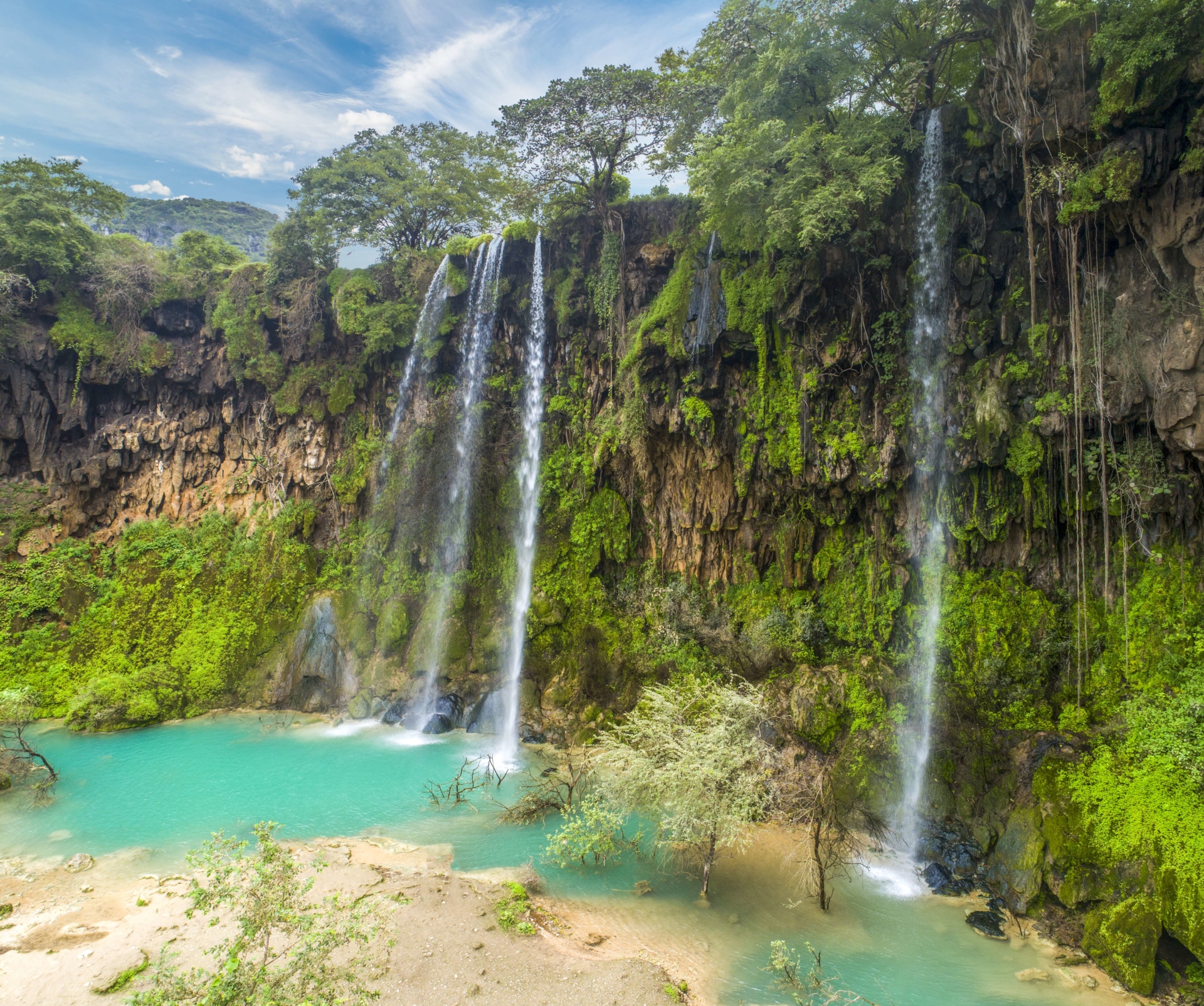
Salalah is the capital of Dhofar province in southern Oman. It is known for its banana plantations, its beaches on the Arabian Sea and its waters teeming with marine life. The kharif, the annual monsoon, transforms the desert lands into a lush landscape, and spawns seasonal waterfalls. The Frankincense Land Museum, within the Al Balid archaeological site, traces the maritime history of the city and its role in the spice trade.
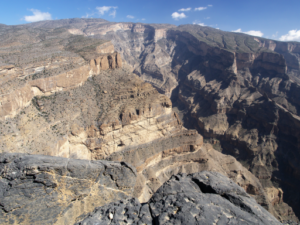
The djebel Shams ("mountain of the sun"), is the highest point of the Sultanate of Oman with 3,009 meters above sea level. It belongs to the Hajar Mountains.

Khor Najd is a towering fjord located in the Musandam Peninsula (Moussandam or Musandam is the peninsula that forms the northeast tip of the Arabian Peninsula. It is located 54 kilometers from the Iranian coast, from which it is separated by the Strait of Hormuz, making it a strategic place).
During a cruise in a dhow (a traditional boat from Oman), Khor Najd offers superb views of the surrounding spectacular mountains, small white sand beaches and clear waters where you may see dolphins.
A small mountain range located east of Salalah, Jebel Samhan extends its wooded foothills over the coastal plain of Mirbat. The terrain is rugged: narrow gorges and high passes.
It abounds with tropical vegetation and numerous frankincense tree forests. The meadows of the high valleys (the massif culminates at 2,100 m) serve as meadows for cattle, a surprising image!
A distinguished guest lodges here: the Arabian leopard, a small panther recognizable by its rosette-spotted yellow coat, which is the smallest representative of the species. Fond of gazelles, Nubian ibex and small mammals, according to the International Union for Conservation of Nature, it is "critically endangered". Only 600 individuals remain on the peninsula. The creation of the reserve is its last chance.
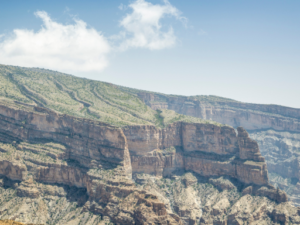 The majestic mountains of the Hajar Mountains reveal a wide variety of superb landscapes. The highest point in the country at nearly 3100 meters, the Jebel Shams, literally the "mountain of the sun", lends itself to a superb trek nicknamed the "balcony walk" because of its path along the steep ridge. The approximately 5-hour walk is suitable for everyone and offers stunning views. The opportunity to marvel at the vertiginous "Grand Canyon of Arabia" and its Wadi Ghul gorge plunging 1,000 meters into the void. The most motivated will embark on the W4 track which will take them in 10 hours to nearly 3,000 meters, on the southern summit of the mountain.
The majestic mountains of the Hajar Mountains reveal a wide variety of superb landscapes. The highest point in the country at nearly 3100 meters, the Jebel Shams, literally the "mountain of the sun", lends itself to a superb trek nicknamed the "balcony walk" because of its path along the steep ridge. The approximately 5-hour walk is suitable for everyone and offers stunning views. The opportunity to marvel at the vertiginous "Grand Canyon of Arabia" and its Wadi Ghul gorge plunging 1,000 meters into the void. The most motivated will embark on the W4 track which will take them in 10 hours to nearly 3,000 meters, on the southern summit of the mountain.
Facing the Jebel Shams, the Jebel Akhdar or "green mountain" is home to villages perched on the side of cliffs and terraced crops that can be discovered along rocky and spectacular paths.
Plans for the first railway between the UAE and Oman are progressing well, not least because a $3 billion investment agreement has been signed.
Oman and UAE-Oman rail network developer Etihad Rail Company have also just signed an agreement with Mubadala Investment Company to develop the 303 km route.
The agreement assists in the "planning and execution" of the UAE-Oman rail network, widely known as the Etihad Rail project, which will connect the Gulf countries.
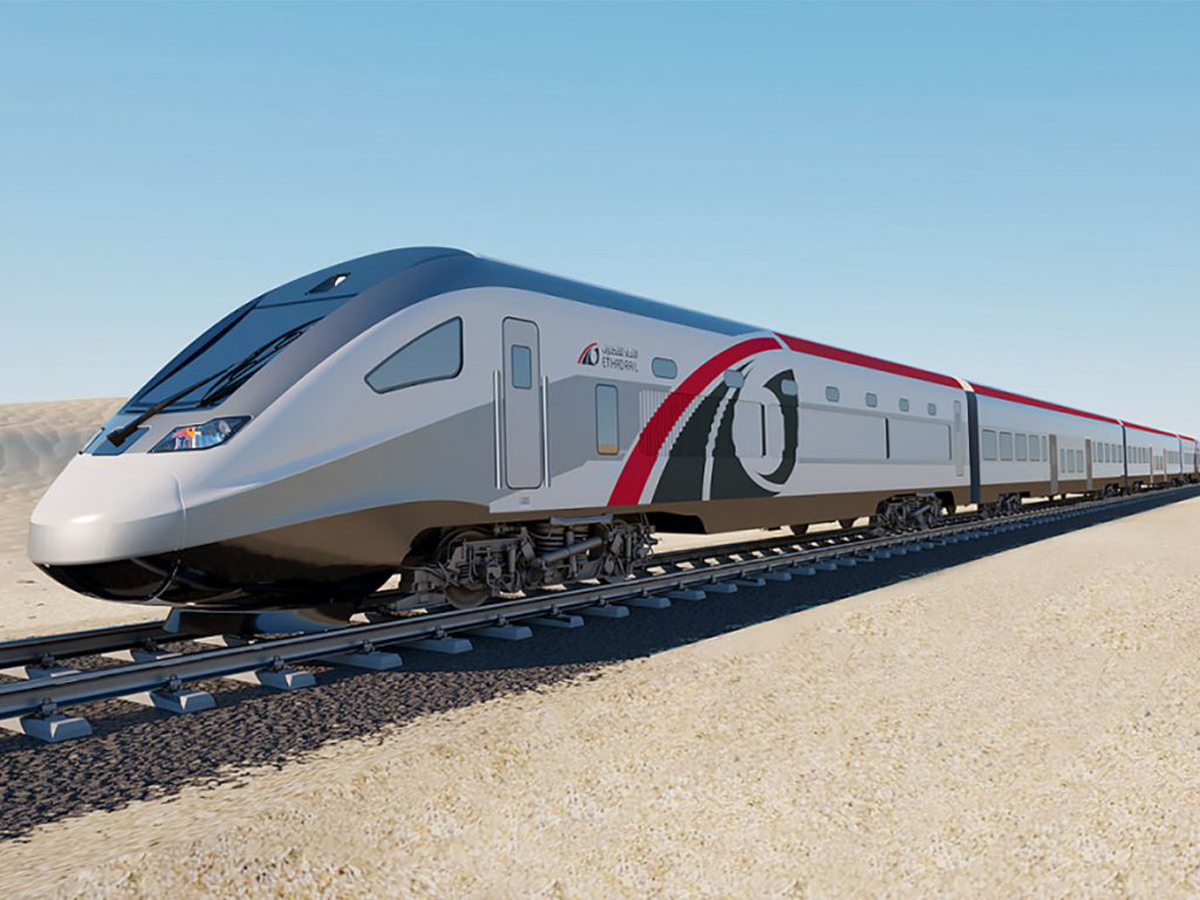
To reach the most remote places, the best thing is to rent a car. In Oman, the car is used by everyone and all the time, so much so that there are very few sidewalks, even in town! The roads are also in very good condition, the signs are written in the Arabic and Latin alphabets and the locals drive quite carefully. We advise you to rent a 4×4 if you plan to go to the wadis or the desert.
There is a fairly developed network of public buses for tourists and expats. These buses mainly connect the big cities to each other. Punctual and comfortable, they are an interesting alternative if you don't want to drive there and just want to visit a city or two.
Find more updated information on Tourism in Oman in our Blog Tourismer.io

MEDRC est une organisation internationale mandatée pour trouver des solutions à la pénurie d’eau douce. Créé en 1996 dans le cadre du processus de paix au Moyen-Orient, il mène des projets de recherche, de formation, de coopération au développement et d’eau transfrontalière.